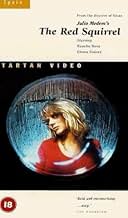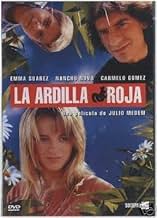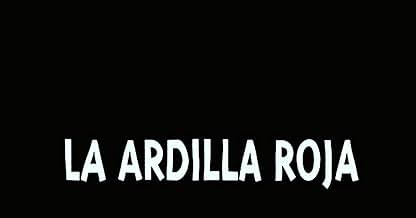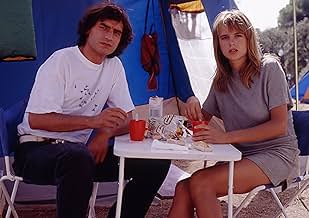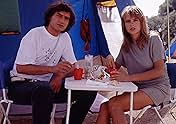A suicidal, has-been rock star tells an amnesiac woman they are longtime lovers after he witnesses her crash her motorcycle.A suicidal, has-been rock star tells an amnesiac woman they are longtime lovers after he witnesses her crash her motorcycle.A suicidal, has-been rock star tells an amnesiac woman they are longtime lovers after he witnesses her crash her motorcycle.
- Awards
- 12 wins & 5 nominations total
Susana García Díez
- Eli
- (as Susana García)
- Director
- Writer
- All cast & crew
- Production, box office & more at IMDbPro
Featured reviews
While struggling to have courage to jump off from a bridge to commit suicide, the musician Jota (Nancho Novo) that misses his girlfriend witnesses an accident with a motorcycle, with the rider falling down on the beach. Jota helps the unknown woman that has amnesia and goes in the ambulance with her to the hospital. Jota invents her name, calling her Lisa (Emma Suárez), and also that they have been living together for four years in his apartment nearby the beach. On the next morning, Jota visits Lisa, who is in session with the psychologist; then he leaves the hospital with her telling that she was discharged. Jota reinvents Lisa's past and travels with her to the camping "La Ardilla Roja", where they befriend the family of a taxi driver. When a stranger comes to the camping claiming that Lisa's name is Sophia indeed and that he is her husband, Jota feels trapped in his lies and questions whether Sophia has had amnesia.
"La Ardilla Roja" is a weird and entertaining love story, with an original and surrealistic screenplay and bizarre characters and situations. The gorgeous Emma Suárez has a stunning performance and shows a great chemistry with the odd and unusual Jota, performed by Nancho Novo. The climax with the arrival of Felix to the camp site is strange and a little disappointing, but the happy end fits well to the plot. My vote is seven.
Title (Brazil): "O Esquilo Vermelho" ("The Red Squirrel")
"La Ardilla Roja" is a weird and entertaining love story, with an original and surrealistic screenplay and bizarre characters and situations. The gorgeous Emma Suárez has a stunning performance and shows a great chemistry with the odd and unusual Jota, performed by Nancho Novo. The climax with the arrival of Felix to the camp site is strange and a little disappointing, but the happy end fits well to the plot. My vote is seven.
Title (Brazil): "O Esquilo Vermelho" ("The Red Squirrel")
'The Red Squirrel' starts off like a Hitchcockian thriller, but soon becomes more complex and difficult to categorize. By the end of this utterly fascinating movie I would be hard pressed to label it. "A mystery" and "a love story" don't give you the whole picture. Just see it for yourself if you want something challenging and original. I know nothing about writer/director Julio Medem, but after watching this film I will rectify that as soon as possible! The basic plot is fairly simple - a washed up pop star contemplates suicide. Before he can do so he witnesses a road accident, a motorbike crash. A young girl is injured slightly but appears to be amnesiac. On the spur of the moment he tells her that he is her boyfriend and invents a name for her (Lisa, his ex-girlfriend, who he still loves). He visits her as she recuperates in hospital, and as it looks more and more likely that he will be found out, he smuggles her out and takes her on a camping holiday. Then things get a bit strange... The plot as I said is fairly simple, but the movie is not. I was hooked from the opening scenes and was fascinated until the very end. I really enjoyed this movie and highly recommend it.
Intense as well as offbeat/intriguing drama with top-notch acting , superb photography and sensitive soundtrack . This brooding picture contains a magnificent performance by a beautiful woman , Emma Suarez , and a good support cast full of prestigious players giving right performances . It deals with Sofia (Emma Suarez) who suffers a motorcycle accident and loses her memory . Jota (Nanco Novo) is a musician, (Susana Gimenez) affected when misses his girlfriend , as he witnesses a motorcycle accident . When he meets Sofia who suffers amnesia , he then takes advantage of the deeds and reinvents her name as Lisa and her life according to his desires . Sofia/Lisa impacts on a great scale about Jota's life . As he makes up a name for her and tells the doctors (Ana Gracia , Txema Blasco , Cheta Lera) that they live together as a couple for several years . Later on , they go to a holiday camping and become involved with a couple called Antón (Karra Elejalde), a cabman , Carmen (María Barranco) and their children . After that , there appears a strange character named Felix (Carmelo Gómez) related to her .
Spanish production with fine acting , colorful cinematography , excellently interpreted and rousing score by Alberto Iglesias . Julio Medem directed the film for Sogetel and producer Enrique López Lavigne and it was released in 1993 . Set in San Sebastian or Donostia and at a lagoon in Pelayos De Presa , this interesting and thought-provoking film dealing with a story of solitary people , as a strange , unsettling young , well played by Nancho Novo , desperate after separating from his girlfriend , as well as a twenty-five-years-old girl riding a motorcycle and falling off a bridge , subsequently suffering amnesia , being splendidly performed by Emma Suarez . The picture was considered by the prestigious ¨Daily Telegraph¨ : as taut and intricate as anything by Alfred Hitchcock . This is a thrilling , exciting , deliberate though magnetic drama . It contains marvelous photography , breathtaking musical score and enjoyable production design . It is a riveting film though sometimes a little boring , slow-pace and overlong . Anyway, the film is interesting , thematically intriguing and strange ; Medem has his own style of telling a story . Very good support cast such as Maria Barranco , Chete Lera , Cristina Marcos ,Txema Blasco , Ana Gracia , Monica Molina and Karra Elejalde , Julio Medem's ordinary . Thrilling as well as sensitive musical score mirroring well the scenery, its people and the story line, it was superbly composed by several times Oscar nominated Alberto Iglesias , Julio Medem's usual . In addition , a spotless pictorial cinematography by Gonzalo Fernandez and a willingness , almost perfect of the elements of each shot , every sequence , every space ; being rightly filmed on location in Pelayos De la Presa, El Pardo , San Martín Valdeiglesias, Madrid, Usanos, Guadalajara and San Sebastián, Guipúzcoa, País Vasco .
The motion picture was well produced by Fernado Garcillan and originally directed by Julio Medem ; this his second movie, "Ardilla Roja" or ¨The red squirrel¨ released in 1993, was selected for the Cannes Film Festival and it confirmed Medem's talents and won prizes in Fort Lauderdale, Bogota and Bucarest . Medem had been making short movies with a super-8 camera owned by his father until he received a call from a new production company called Sogetel and executive producers Fernando de Garcillán , José Luis Olaizola , Enrique López Lavigne . They were interested in his script titled "Vacas" . It won the Goya Award from the Spanish academy for best new director, and won prizes in the festivals of Tokyo, Torino and Alexandria. In 1998 Medem released " The lovers of the Polar Circle ," considered his best movie by most of his fans . It also became a box-office hit with more than one million spectators in Spain and was also released worldwide. In 2001 his fourth movie, "Lucia and sex ," became a huge hit and began the career of actress Paz Vega who won the Goya for best new actress . Although in 2003 failed with the release , "The Basque ball" , a documentary that portrays the phenomenon of nationalism and terrorism in the Basque Country of northern Spain , it was very polemical and partial . In 2007 directed the flop ¨Caotica Ana¨ and in 2010 , ¨Room in Rome¨, a successful though with not sense film , plenty of nudism and only starred by two gorgeous naked girls . Julio Medem is for sure one of the the most important and original Spanish filmmaker. Well worth watching if you get the chance .
Spanish production with fine acting , colorful cinematography , excellently interpreted and rousing score by Alberto Iglesias . Julio Medem directed the film for Sogetel and producer Enrique López Lavigne and it was released in 1993 . Set in San Sebastian or Donostia and at a lagoon in Pelayos De Presa , this interesting and thought-provoking film dealing with a story of solitary people , as a strange , unsettling young , well played by Nancho Novo , desperate after separating from his girlfriend , as well as a twenty-five-years-old girl riding a motorcycle and falling off a bridge , subsequently suffering amnesia , being splendidly performed by Emma Suarez . The picture was considered by the prestigious ¨Daily Telegraph¨ : as taut and intricate as anything by Alfred Hitchcock . This is a thrilling , exciting , deliberate though magnetic drama . It contains marvelous photography , breathtaking musical score and enjoyable production design . It is a riveting film though sometimes a little boring , slow-pace and overlong . Anyway, the film is interesting , thematically intriguing and strange ; Medem has his own style of telling a story . Very good support cast such as Maria Barranco , Chete Lera , Cristina Marcos ,Txema Blasco , Ana Gracia , Monica Molina and Karra Elejalde , Julio Medem's ordinary . Thrilling as well as sensitive musical score mirroring well the scenery, its people and the story line, it was superbly composed by several times Oscar nominated Alberto Iglesias , Julio Medem's usual . In addition , a spotless pictorial cinematography by Gonzalo Fernandez and a willingness , almost perfect of the elements of each shot , every sequence , every space ; being rightly filmed on location in Pelayos De la Presa, El Pardo , San Martín Valdeiglesias, Madrid, Usanos, Guadalajara and San Sebastián, Guipúzcoa, País Vasco .
The motion picture was well produced by Fernado Garcillan and originally directed by Julio Medem ; this his second movie, "Ardilla Roja" or ¨The red squirrel¨ released in 1993, was selected for the Cannes Film Festival and it confirmed Medem's talents and won prizes in Fort Lauderdale, Bogota and Bucarest . Medem had been making short movies with a super-8 camera owned by his father until he received a call from a new production company called Sogetel and executive producers Fernando de Garcillán , José Luis Olaizola , Enrique López Lavigne . They were interested in his script titled "Vacas" . It won the Goya Award from the Spanish academy for best new director, and won prizes in the festivals of Tokyo, Torino and Alexandria. In 1998 Medem released " The lovers of the Polar Circle ," considered his best movie by most of his fans . It also became a box-office hit with more than one million spectators in Spain and was also released worldwide. In 2001 his fourth movie, "Lucia and sex ," became a huge hit and began the career of actress Paz Vega who won the Goya for best new actress . Although in 2003 failed with the release , "The Basque ball" , a documentary that portrays the phenomenon of nationalism and terrorism in the Basque Country of northern Spain , it was very polemical and partial . In 2007 directed the flop ¨Caotica Ana¨ and in 2010 , ¨Room in Rome¨, a successful though with not sense film , plenty of nudism and only starred by two gorgeous naked girls . Julio Medem is for sure one of the the most important and original Spanish filmmaker. Well worth watching if you get the chance .
Julio Medem is something of an underrated figure within the spectrum of world cinema. He regularly produces bold, imaginative and exciting films that shatter the usual preconceptions we might have of the limitations of cinematic language and storytelling in the visual sense, as well as presenting an incredibly intelligent and original approach to the ideas of production design, editing and cinematography. Despite this, however, he has yet to be fully acclaimed universally as a great filmmaker in the tradition of Tarkovsky, Bergman, Hitchcock, Kubrick, Godard, Welles etc - or even ranked alongside contemporary cinematic figures such as Pedro Almodóvar, Lars von Trier, Aki Kaurismäki, Michael Haneke and Guillermo Del Toro. The Red Squirrel (1993) was only Medem's second feature following the elliptical historical satire Vacas (1991) and yet, even now we can already see the themes from that particular film being further developed in preparation for the later, perhaps even great films, such as Tierra (1996), The Lovers of the Arctic Circle (1998) and Sex and Lucia (2001).
Like those films, The Red Squirrel is a multi-layered work rife with possible interpretations and elements of broad, Buñuelian surrealism that are at odds with the more recognisable presentation of reality established in the film's intriguing first half. On our initial viewing the plot can seem incredibly straightforward, revolving around the strange relationship between a suicidal former pop star and the mysterious, amnesiac woman who literally falls into his life. With this section of the film, Medem creates a truly unique modern-day thriller, building on elements of Hitchcock - most noticeably Vertigo (1957), with its iconographical depictions of mysterious blondes, shadowy villains, damaged heroes and seething paranoia - but intelligently subverting them by way of elements as diverse as Salvador Dali, the aforementioned Buñuel, low-budget B-movies, The Road Warrior (1980), elements of magical realism and ideas central to the Basque regional identity; again, drawing parallels with the hypnotic and self-reflexive world of Vacas. These subtle editions compliment the more recognisable characteristics of the romantic-thriller mystery story at the heart of the film to create something that is much more engrossing, enticing, and unique.
As the story progresses and we are drawn ever deeper into the film's central mystery, we begin to note the emergence of further plot influences, such as psychological horror, melodramatic eroticism, heart-stopping suspense, black comedy and eventually full-blown surrealism. As it does, the film then becomes much more complex, taking on issues of love, sexuality, mental and physical manipulation, mind-games and cinematic role-playing. Medem ties the whole thing together with some wonderful set pieces and a staggering use of cinematic style put together on an obviously limited budget. It isn't purely the imagination and intelligence of Medem that impresses us though; with every wild narrative U-Turn or directorial flourish - incorporating everything from Kiss Me Deadly (1955) to Raising Arizona (1987) - being backed up by the fine performances from lead actors Nancho Novo and Emma Suárez, both of whom manage to makes us care an enormous amount about these two protagonists and the relationship that forms between them.
Although it's always tempting to say that both Medem and his work is unlike anything else you will ever see; I think there are some obvious reference points here, many of which have been mentioned above, as well as a certain similar approach to filmmakers such Krzysztof Kieslowski - with the deep, meditative and vaguely hypnotic use of camera combined with the intricate presentation of a narrative driven by the purely psychological; most apparent for example in his epic TV series Dekalog (1989) and one of his greatest films, The Double Life of Veronique (1991) - and especially a filmmaker like Wong Kar-Wai, with the idea of the lead character's enigmatic pop song describing the narrative and the central location manipulating the story so as to take on more self-reflexive, metaphorical notions being very much in keeping with films such as like Happy Together (1997), In the Mood for Love (1999) and 2046 (2004).
As with much of Medem's work, including the 2001 erotic mystery thriller Sex and Lucia, the film uses much in the way of cinematic coincidences, with the various coincidences that form the basis of the plot acting as clues to the narrative. This turns the film into a wonderful example of cinematic storytelling, creating a real mystery for the audience in which all the pieces fall perfectly into place during the film's final act, but still leave us room for interpretation. Without question, this is a delightful cinematic experience that goes way beyond the limitations of film; elaborating on some of the complex ideas regarding narrative, time, character and spirit presented in Vacas, whilst simultaneously foreshadowing the ideas of escape, transcendence, imagination, eroticism and the notion of a story being written as it goes, which will all be further developed in Sex and Lucia. With this in mind, The Red Squirrel is an absolute marvel; an epic, ornate jigsaw-puzzle for the audience, and - without question - one of the greatest films of the 1990's.
Like those films, The Red Squirrel is a multi-layered work rife with possible interpretations and elements of broad, Buñuelian surrealism that are at odds with the more recognisable presentation of reality established in the film's intriguing first half. On our initial viewing the plot can seem incredibly straightforward, revolving around the strange relationship between a suicidal former pop star and the mysterious, amnesiac woman who literally falls into his life. With this section of the film, Medem creates a truly unique modern-day thriller, building on elements of Hitchcock - most noticeably Vertigo (1957), with its iconographical depictions of mysterious blondes, shadowy villains, damaged heroes and seething paranoia - but intelligently subverting them by way of elements as diverse as Salvador Dali, the aforementioned Buñuel, low-budget B-movies, The Road Warrior (1980), elements of magical realism and ideas central to the Basque regional identity; again, drawing parallels with the hypnotic and self-reflexive world of Vacas. These subtle editions compliment the more recognisable characteristics of the romantic-thriller mystery story at the heart of the film to create something that is much more engrossing, enticing, and unique.
As the story progresses and we are drawn ever deeper into the film's central mystery, we begin to note the emergence of further plot influences, such as psychological horror, melodramatic eroticism, heart-stopping suspense, black comedy and eventually full-blown surrealism. As it does, the film then becomes much more complex, taking on issues of love, sexuality, mental and physical manipulation, mind-games and cinematic role-playing. Medem ties the whole thing together with some wonderful set pieces and a staggering use of cinematic style put together on an obviously limited budget. It isn't purely the imagination and intelligence of Medem that impresses us though; with every wild narrative U-Turn or directorial flourish - incorporating everything from Kiss Me Deadly (1955) to Raising Arizona (1987) - being backed up by the fine performances from lead actors Nancho Novo and Emma Suárez, both of whom manage to makes us care an enormous amount about these two protagonists and the relationship that forms between them.
Although it's always tempting to say that both Medem and his work is unlike anything else you will ever see; I think there are some obvious reference points here, many of which have been mentioned above, as well as a certain similar approach to filmmakers such Krzysztof Kieslowski - with the deep, meditative and vaguely hypnotic use of camera combined with the intricate presentation of a narrative driven by the purely psychological; most apparent for example in his epic TV series Dekalog (1989) and one of his greatest films, The Double Life of Veronique (1991) - and especially a filmmaker like Wong Kar-Wai, with the idea of the lead character's enigmatic pop song describing the narrative and the central location manipulating the story so as to take on more self-reflexive, metaphorical notions being very much in keeping with films such as like Happy Together (1997), In the Mood for Love (1999) and 2046 (2004).
As with much of Medem's work, including the 2001 erotic mystery thriller Sex and Lucia, the film uses much in the way of cinematic coincidences, with the various coincidences that form the basis of the plot acting as clues to the narrative. This turns the film into a wonderful example of cinematic storytelling, creating a real mystery for the audience in which all the pieces fall perfectly into place during the film's final act, but still leave us room for interpretation. Without question, this is a delightful cinematic experience that goes way beyond the limitations of film; elaborating on some of the complex ideas regarding narrative, time, character and spirit presented in Vacas, whilst simultaneously foreshadowing the ideas of escape, transcendence, imagination, eroticism and the notion of a story being written as it goes, which will all be further developed in Sex and Lucia. With this in mind, The Red Squirrel is an absolute marvel; an epic, ornate jigsaw-puzzle for the audience, and - without question - one of the greatest films of the 1990's.
Great movie. It grabs you from the start, exciting...a bit obvious at some moments, lots of symbolism, power plays and psychological projections. I saw the movie on video, but I believe this one is definitely one for the big screen. It is enchanting. The end of the movie is a little bit farfetched and overdone (unlike the better Tierra, Los Amantes and Sex and Lucia (my personal favorite)) but this is only a minor comment.
Great to know that Medem will be delivering more inspiring movies :-)))
9 out of 10.
Great to know that Medem will be delivering more inspiring movies :-)))
9 out of 10.
Did you know
- TriviaStanley Kubrick was such a fan of the film, he purchased Julio Medem's own personal print.
- ConnectionsReferenced in Brows Held High: Room in Rome (2013)
- How long is The Red Squirrel?Powered by Alexa
Details
- Runtime1 hour 54 minutes
- Color
- Sound mix
- Aspect ratio
- 1.85 : 1
Contribute to this page
Suggest an edit or add missing content



